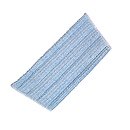How to Clean Microfiber
To clean microfiber cleaning cloths is a fairly simple task, although
the
process is a bit different depending on the quality you have purchased. Lower quality microfiber requires more care than higher quality. Like all cleaning cloths, microfiber can get smelly if left in a ball; the best solution is to put vinegar in the wash water, or soak with a little vinegar for a few minutes prior to washing.
To Clean Microfiber Cloths of the Highest Quality
(.14 denier or 1/100 the size of a human hair)
These are the cloths that are able to remove both soils and pathogens from hard surfaces without the aid of any chemicals. These are the most expensive cloths ($20 - $40 each) , but there are different sources, and wisely chosen, can save you hundreds of dollars and hours of time over the long run! Norwex cloths are the best buy.
1. If the cloths are slightly soiled, wash with some warm water and a small amount of dish washing liquid. Scrub lightly, rinse, squeeze out excess water, and let dry.
2. If they are really dirty - put in the washer and dryer. Any temperature water is fine, but a really hot wash every once in a while will help the fibers release stains. Please, no bleach, and no fabric softener.
3. Every once in a while, or if they are stained, boil in plain water for 10 minutes. The boiling water will relax the fibers to refresh their ability to absorb, and will release much of the stain.
To Clean Microfiber of Medium Quality
(about 1/40 - 1/60 the size of a human hair)
These cloths do not require the use of chemical cleaners, but still require disinfectants to remove pathogens. If you are not ready to go completely chemical free, but want to enhance the performance of homemade cleaning products, these are a good value for money. Rubbermaid makes a good cloth in this range that is normally available retail at industrial cleaning suppliers.
1. If the cloths are slightly soiled, wash with some warm water and a small amount of dish washing liquid. Scrub lightly, rinse, squeeze out excess water, and let dry.
2. If they are really dirty, they should be able to go through the wash machine, but not all of them can tolerate the dryer. You will need to discover the limitations of your particular cloths, or just accept a reduced life-span in exchange for convenience. Again, avoid bleach and fabric softener. Bleach will eventually destroy most microfibers, and fabric softener coats them so that they won't work properly. If you accidentally use fabric softener - not to worry. Just wash them again and they should be as good as new.
3. These cloths should stand up to boiling to remove stains and refresh performance .
To Clean Microfiber of Low Quality
(normally 1/6 - 1/20 the size of a human hair)
These cloths should not be used without cleaners and disinfectants to remove dirt and pathogens, although they help both to work better. This is what you will get from most retail outlets, and dollar store cloths will be at the bottom of the quality scale (to no one's surprise I hope!)
All I can say is read the instructions. These cloths will rarely stand up to the wash machine, and almost never in the dryer. No matter what you do to clean them, do not expect a long life-span.
These often require hand-washing and hanging to dry.
Back to
House Cleaning
Home Page from
Clean Microfiber
Related Topics
Related Products


